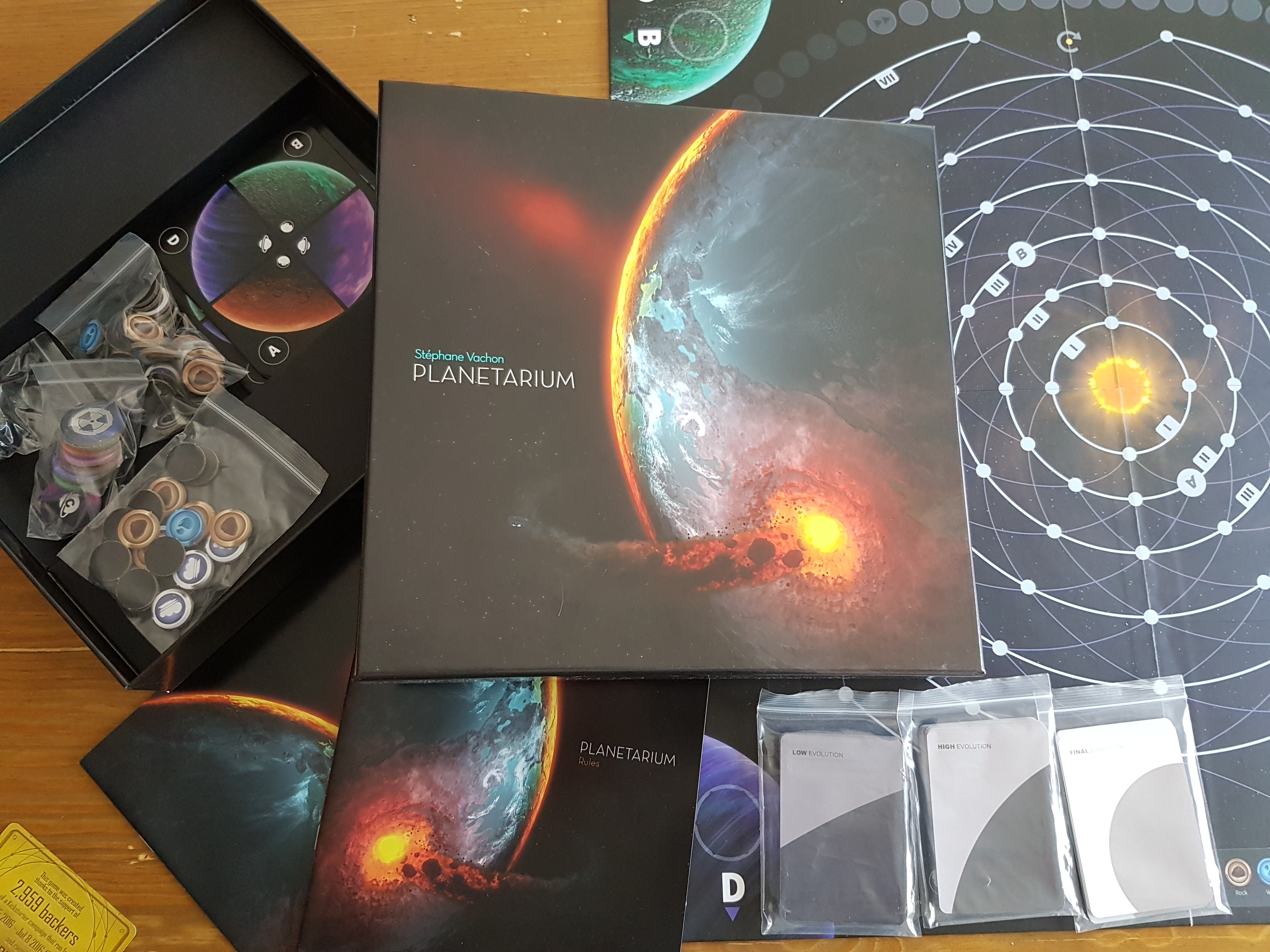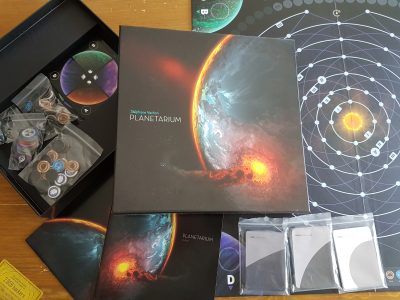Towards the end of the game the board starts to open up, with a lot less Matter tokens left to collect. To stop the play slowing down past a certain point players can move Matter tokens two spaces on the board. This in combination with Planetary movement being unlimited on the thick orbit rings, until a collision with Matter occurs, sees planets starting to hurtle around the star at the centre of the board, often spoiling plans of others vying to complete Final Evolution card conditions.
There is also an ability, called Gravity, on certain High Evolution cards that enables players to take any Matter token from the board when a card with the gravity symbol is played. This means it isn’t impossible to get Matter from the other side of the board or in completely different orbits, reducing the luck element of the randomly distributed Matter tokens. Without this players could find it impossible to complete the Final Evolution card they receive at the start of the game, disheartening them form the offset. There still is a luck element, of where the Matter tokens you need are on the board, but this ability to take a token from anywhere reduces the impact of this luck on the final result of the game.
Coming from an astrophysics background this game does a great job of taking space based concepts and making them actually fun. The theme of Planetarium is awesome and extends through every element of the game. Planets orbiting around with meteor shows, moons disintegrating and atmospheres being created; the board and the cards work seamlessly together. It also goes hand in hand with several of the game’s mechanics. Not making sense of them but interlinking with them, strengthening both. Despite the game not being overly complicated to play the theme does panic some new players into thinking it’ll be a lot more complex. Some see the board and think the complex physics behind it is something the game will draw on. This is far from the case, but for those whom know and understand the physics, Planetarium doesn’t disregard them either.
A game of Planetarium plays fairly quickly with little downtime. As players move planets it can, and often will, affect what you can do on your turn. In turn this affects what matter tokens you have the potential to collect and even what cards you can play on your next turn. As a result, you have to pay attention to what is going on, on the tokens taken from the game board and the position of planets, even when it’s not your turn.
The rule book keeps things short, to the point and does a great job of explaining the mechanics of the game. It has a great step by step turn order for players to stick to and allows new players to understand the concepts of the game within minutes. I also love the astrophysics content found in the back of the rulebook. This only extends onto the cards where nuggets of factually correct information can be found. People that want to learn some space based trivia can read it and those whom don’t can simply enjoy the beautiful artwork that adorns the cards.
The artwork truly elevates Planetarium from a generally pleasant looking board game to an amazing one. Most use the same planet positioning but with very different things happening to the planet below. The habitable cards often show a peaceful looking planet with green lands welcoming life. Conversely, hostile cards show the planet below often in ruins being bombarded by one terror or another.
One problem I found when teaching new players Planetarium was their preconceptions when seeing the board laid out on the table in front of them. New players automatically thought they would be playing as an individual planet instead of being able to affect all of the four planets. In the first game players have the tendency to focus solely on one planet. If you play your cards right, making an individual planet have the perfect habitability conditions for your Final Evolution card could be a way to win but it is best to evolve traits on all four planets to maximise your chances.
It may be a tiny inclusion in the box but the small plastic bags supplied do wonders for keeping the box neat. More importantly for those whom don’t have board game box OCD, in the long term this will help the components stay pristine for longer. It’s a nice touch that I wish more board games would include and shows that the developers of Planetarium have thought about the players of their game and aren’t just there to sell them the game.
Planetarium isn’t a complex game by any nature and if you can get players to see past their pre-conceptions of science then everyone, of multiple ages, will enjoy the game. This extends to making Planetarium a great family game where children can get interested in the subject of space and planets. Within an hour of opening the box you’ll have comfortably learnt the rules and gone on to complete your first game and I’m sure you won’t want it to be your last. I can see Planetarium often being deployed to the table, as one part of a gaming night or even the main event itself! Planetarium has firmly earnt its space, pun intended, on my gaming shelf for a long time.
[Editor’s Note: Planetarium was provided to us by Game Salute for review purposes.]




